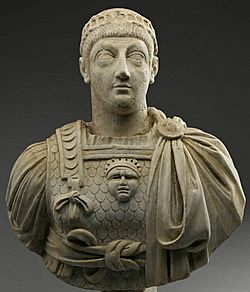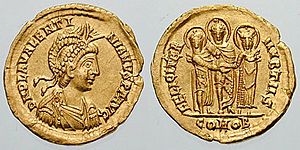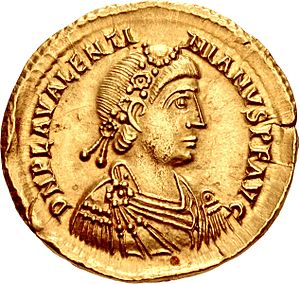Valentinian III facts for kids
Quick facts for kids Valentinian III |
|||||
|---|---|---|---|---|---|

Head portrait set in a modern bust, Louvre.
|
|||||
| Roman emperor in the West | |||||
| Augustus | 23 October 425 – 16 March 455 | ||||
| Predecessor | Joannes | ||||
| Successor | Petronius Maximus | ||||
| Eastern emperors |
Theodosius II (425–450) Marcian (450–457) |
||||
| Born | 2 July 419 Ravenna |
||||
| Died | 16 March 455 (aged 35) Rome |
||||
| Burial | Mausoleum of Honorius | ||||
| Spouse | Licinia Eudoxia | ||||
| Issue | Eudocia Placidia |
||||
|
|||||
| Dynasty | Valentinianic and Theodosian | ||||
| Father | Constantius III | ||||
| Mother | Galla Placidia | ||||
| Religion | Christianity | ||||
Valentinian III (Latin: Placidus Valentinianus; born July 2, 419 – died March 16, 455) was a Roman emperor in the Western Roman Empire. He ruled from 425 to 455, becoming emperor when he was just a child. His time as emperor was one of the longest, but it was also a very challenging period.
Powerful generals often fought for control, and there were many civil wars. The empire also faced invasions from different groups during a time called the Migration Period. One of the most famous invaders was Attila the Hun.
Valentinian was the son of Galla Placidia and Constantius III. He was also the great-grandson of Valentinian I, making him the last emperor from the Valentinianic dynasty. Through his other grandparent, Theodosius I, he was also part of the Theodosian dynasty. His wife, Licinia Eudoxia, was also from this family.
Before becoming a full emperor (called augustus), Valentinian was given the title of caesar by his cousin, Theodosius II. His mother, Galla Placidia, had a lot of power and influence during his early rule. At first, three powerful generals – Aetius, Felix, and Bonifacius – competed for power. Aetius eventually won and led campaigns against many Germanic tribes invading the empire.
During Valentinian's reign, the Huns invaded the Roman Empire. Aetius famously defeated them at the Battle of the Catalaunian Plains. Later, when the Huns returned, Pope Leo I and two senators convinced Attila to leave Italy. Sadly, Valentinian himself killed Aetius. In revenge, Aetius's bodyguards assassinated Valentinian. His reign is remembered as a time when the Western Roman Empire began to fall apart.
Contents
Valentinian's Early Life and Family
Valentinian was born in Ravenna, which was the capital city of the Western Roman Empire. He was the only son of Galla Placidia and Flavius Constantius. His mother was the younger half-sister of the Western emperor Honorius. His father was a very important and powerful person behind the emperor.
Through his mother, Valentinian was related to two important emperors: Theodosius I (his grandfather) and Valentinian I (his great-grandfather). He was also the nephew of Emperor Honorius and a first cousin to Theodosius II, who was the Eastern Roman emperor for most of Valentinian's life.
Valentinian had a full sister named Justa Grata Honoria, who was probably born in 417 or 418. His mother had been married before to Ataulf, a king of the Visigoths. They had a son named Theodosius, but he died when he was very young.
When Valentinian was less than two years old, his father, Constantius, became co-emperor with Honorius. However, Constantius died just seven months later. Because of all these family connections, Valentinian was the son, grandson, great-grandson, cousin, and nephew of Roman emperors.
Around 421 or 423, Emperor Honorius gave Valentinian the special title of nobilissimus. However, the Eastern Roman court led by Theodosius II did not immediately accept this title. After his father died in 421, Valentinian, his mother, and his sister moved to Constantinople. This happened because of problems at the court in Ravenna, which forced Galla Placidia to leave her half-brother, Emperor Honorius. Young Valentinian then lived at the court of his cousin, Theodosius II.
Becoming Emperor: From Caesar to Augustus
How Valentinian Became Caesar
In 423, Emperor Honorius died. A man named Joannes then took power in Rome. To stop Joannes, Emperor Theodosius II in the East finally recognized Valentinian's father as a past emperor. On October 23, 424, Theodosius named the 5-year-old Valentinian as caesar for the West. This title meant he was a junior emperor and heir.
Theodosius also promised Valentinian would marry his own daughter, Licinia Eudoxia. Valentinian eventually married her in 437 when he was 18.
Valentinian Becomes Augustus
The next year, Joannes was defeated by a combined army and navy. On October 23, 425, Valentinian was officially made augustus (full emperor) in Rome. He was only six years old. This was done by Helion, an important official from the Eastern Empire.
Because Valentinian was so young, his mother, Galla Placidia, was the real power behind the throne. One of her first actions was to appoint Felix as the main general in the West. During this time, the empire tried hard to bring stability to its western provinces.
In 425, the Roman court made a deal with the Huns. These Huns had come to Italy to support Joannes. They agreed to leave Italy and give back the province of Pannonia Valeria to the empire. This allowed Felix and the government to strengthen defenses along the Danube River in 427 and 428. The Romans also won important battles against the Visigoths in Gaul (426-427 and 430) and the Franks along the Rhine River (428 and 432).
However, the Western Roman Empire still faced huge problems. The Visigoths were always present in southeastern Gaul and could not be fully removed. The Vandals in Hispania continued their attacks. In 429, they began invading Mauretania Tingitana in North Africa. Losing these rich areas greatly hurt the empire's ability to collect taxes and function. As Rome's power weakened, people in its remaining provinces became less loyal.
The early part of Valentinian's reign was also marked by a power struggle. Three main generals fought for control: Flavius Felix, Bonifacius, and Flavius Aetius. In 427, Felix accused Bonifacius of being a traitor. Bonifacius refused to return to Italy and defeated an army sent by Felix. Felix was then too weak to stop Aetius. With Galla Placidia's support, Aetius replaced Felix as the main general in 429 and had him killed in 430.
Meanwhile, Bonifacius could not defeat another general sent against him. So, Bonifacius made a deal with the Vandals to help him. In return, they would share the African provinces. The Roman court, especially Galla Placidia, was worried about losing Africa. They made peace with Bonifacius, who then agreed to be loyal to Valentinian III and stop the Vandal king Gaiseric.
In 431, Bonifacius was defeated by the Vandals and fled to Italy, leaving North Africa. The imperial court, worried about Aetius's growing power, removed Aetius from his command and gave it to Bonifacius. A civil war followed, and Bonifacius defeated Aetius at the Battle of Ravenna. However, Bonifacius died from his wounds.
Aetius fled to the Huns. With their help, he convinced the court to give him back his old position as main general in 434. As a result, in 435, Valentinian had to make peace with Gaiseric. The Vandals kept all their lands in North Africa but had to pay tribute to the empire. The Huns were also given new land in Pannonia Savia.
Galla Placidia's time as regent (ruler for a young emperor) ended in 437. Valentinian traveled to Constantinople to marry his fiancée, Licinia Eudoxia. When he returned to Rome, he was officially the emperor. But in reality, Aetius was in charge of the Western Empire's policies.

Aetius Takes Charge
From 436 to 439, Aetius focused on problems in Gaul. He won important victories against the Goths in 437 and 438. However, a Roman defeat in 439 meant things went back to how they were, with a new peace agreement. He also had early success against the Franks and the Burgundians. By 437, he also stopped a rebellion by a group called the Bagaudae. In 438, peace was made with the Suebi in Spain. In the same year, Valentinian's daughter, Eudocia, was born.
While Aetius was busy in Gaul, Valentinian could not stop the Vandals from taking over the rest of the western African provinces. This led to the fall of Carthage on October 19, 439. This was a huge loss because the taxes and food from these rich provinces supported Rome. By 440, Vandal ships were attacking Sicily. Aetius worked with the Eastern Roman court to plan a joint attack on Gaiseric, sending many troops to Sicily.
These plans were stopped because the Huns forced the troops to move to the Danube River to fight their invasions. So, in 442, Aetius and Valentinian had to accept that the Vandals controlled many rich provinces in North Africa. In return, Rome got back some devastated provinces. However, Gaiseric soon took back more land and also captured Sardinia and Corsica. He also launched destructive raids on Sicily.
Aetius believed that if they couldn't stop Gaiseric by fighting, perhaps they could link him to the imperial family. So, before 446, he convinced Valentinian to agree to marry his oldest daughter, Eudocia, to Gaiseric's son, Huneric. Unfortunately, Huneric was already married to the daughter of the Visigoth king, so the idea was dropped.
Hispania (Spain) also continued to slip away from Roman control in the early to mid-440s as the Suebi expanded their power. By 444, almost all Spanish provinces except Hispania Tarraconensis were lost. Even Tarraconensis was under pressure from continued Bagaudic uprisings.
Because of these losses, the government faced serious money problems by the mid-440s. They openly admitted they didn't have enough money for the army. The emperor issued a law on July 14, 444, removing tax breaks for government workers.
That year, two new taxes were created in Valentinian's name. One was a sales tax of about four percent. The other was on the senatorial class, specifically to raise money for new soldiers, their food, and clothing. Even Valentinian himself had to give up some of his own money to help the state.
Hunnic Invasions and Attila
The Huns continued to threaten the Roman provinces along the Danube River in the 440s. Before 449, Valentinian gave the honorary title of magister militum (master of soldiers) of the Western Empire to the Hun chieftain, Attila the Hun. The Western court was relieved when Attila focused on attacking the Eastern Empire's provinces in the Balkans from 441 to 449.
In 449, Attila received a message from Honoria, Valentinian III's sister. She offered him half of the Western Empire if he would save her from a marriage her brother was forcing her into.
Attila had been looking for a reason to invade the West. He was also supposedly paid by the Vandal king Gaiseric to attack the Visigoths in Gaul. In 450, after making peace with the Eastern court, Attila invaded the Gallic provinces. Valentinian was furious about the invasion. The man Honoria sent to Attila was tortured to reveal all the details of the plan and then killed. It took a lot of convincing from Valentinian's mother to get him to spare his sister's life.
In early 451, Attila crossed the Rhine River and entered the Belgic provinces. He captured Divodurum Mediomatricum (Metz) on April 7, 451. Aetius gathered an army, including Visigoths and Burgundians. He quickly moved to stop Attila from taking the city of Aurelianum (Orléans), successfully forcing the Huns to retreat. The Roman-Germanic forces met the Hunnic forces at the Battle of the Catalaunian Plains. Aetius won the battle, but he allowed Attila and many of his troops to escape.
This allowed Attila to gather his forces again. In 452, Attila invaded Italy. He attacked and destroyed Aquileia and also took Verona and Vincentia (Vicenza). Aetius was following the Huns but did not have enough soldiers to attack them directly, so the road to Rome was open. Although Valentinian usually lived in Ravenna, he and his court moved back to Rome as Attila approached.
Valentinian sent Pope Leo I and two important senators to talk with Attila. This meeting, along with a plague among Attila's troops, the threat of famine, and news that the Eastern Emperor Marcian had attacked Hun homelands, forced Attila to turn around and leave Italy. Attila's death in Pannonia in 453 and the power struggle among his sons ended the Hunnic threat to the empire.
The Emperor's Assassination
With the Hun invasion stopped, Valentinian felt safe enough to plan to kill Aetius. He was encouraged by Petronius Maximus, an important senator who disliked Aetius, and his chamberlain (a high-ranking servant), Heraclius. Aetius, whose son had married Valentinian's youngest daughter, Placidia, was murdered by Valentinian on September 21, 454.
The ancient historian Priscus wrote that Aetius was giving a financial report to the Emperor when Valentinian suddenly jumped from his throne. He blamed Aetius for the empire's problems and accused him of trying to take over the empire. Valentinian then drew his sword and, with Heraclius, attacked the unarmed Aetius and killed him on the spot. When Valentinian later bragged about killing Aetius, a wise advisor famously replied, "Whether it was a good thing or not, I don't know. But know that you have cut off your right hand with your left." This meant Valentinian had destroyed his most capable general.
On March 16 of the next year, the emperor himself was assassinated in Rome. Two of Aetius's followers, Optelas and Thraustelas, killed him. According to Priscus, these men were put up to it by Petronius Maximus, who wanted more political power but was blocked by Heraclius. The assassination happened while Valentinian was riding his horse on the Campus Martius. As the emperor got off his horse to practice archery, the attackers struck. Optelas killed Valentinian, and Thraustelas killed Heraclius.
The day after the assassination, Petronius Maximus declared himself emperor. He paid a large sum of money to the remaining Western Roman army. However, he was not prepared to lead and stabilize the weakened empire. After only 11 weeks as emperor, Maximus was killed by a Roman mob. King Gaiseric and his Vandals then captured Rome a few days later and looted it for two weeks.
Valentinian's Character and Impact
Valentinian's reign is known for the breaking apart of the Western Roman Empire. By the time he died, almost all of North Africa, western Spain, and most of Gaul were no longer under Roman control.
He is described as someone who was spoiled and loved pleasure. He was also said to be influenced by sorcerers and astrologers. However, he was also very religious and gave money to churches of Saint Lawrence in both Rome and Ravenna.
He also gave more power to the Papacy (the office of the Pope). On June 6, 445, he issued a law that recognized the Pope as the most important bishop. This law stated that anyone who went against the Pope's rulings would be treated as a traitor. It also allowed provincial governors to force anyone who refused to come to Rome for a summons to do so. Valentinian also focused on smaller issues. For example, in the 430s, he started removing all Jews from the Roman army because he worried they might negatively influence the Christians they served with.
Some historians from the 18th to 20th centuries, like Edward Gibbon and John Bagnall Bury, had negative opinions of Valentinian III.
Images for kids
See also
 In Spanish: Valentiniano III para niños
In Spanish: Valentiniano III para niños



